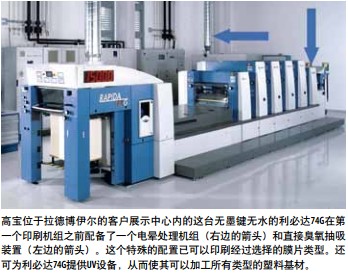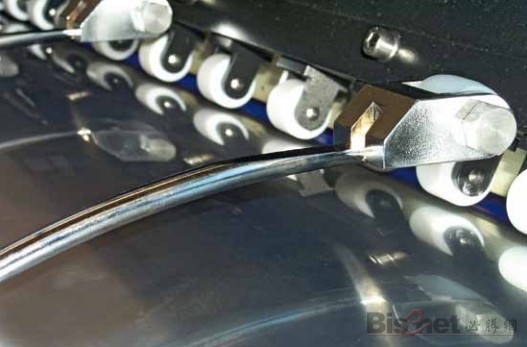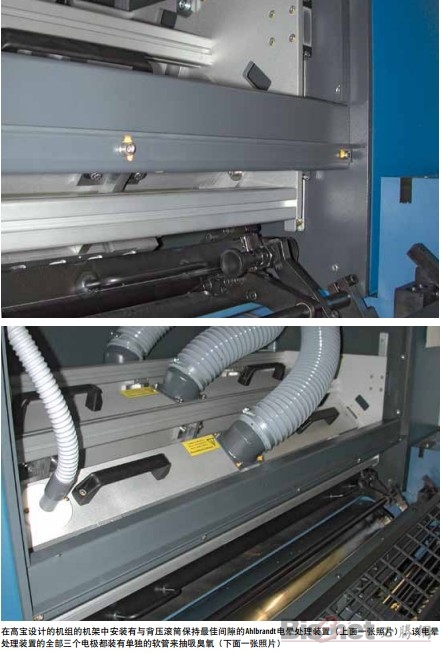Increase surface tension with corona treatment device
Corona treatment is an effective method, which can not only increase the surface tension of plastic film and metalized substrate, but also increase the surface tension of non-absorbent paper and paperboard. Only above about 38 mN / m is the surface tension sufficient to bond the ink. Since the corona effect on the membrane processed by the factory will be reduced during storage, many plastic printers use an online corona system. KBA's partner in this field is AhlbrandtSystemGmbH.
How corona treatment works
Corona treatment is the most frequent method used to improve the printability of the membrane surface. Increasing the surface tension not only provides better adhesion for UV inks and coatings or waterless offset printing inks, but also has the same effect on adhesives.

The word "corona" in Latin refers to a crown or flower crown. If a high voltage is applied to an electrode, an uncontrolled discharge will produce a light blue glowing corona around the electrode-the surrounding air will be "ionized". More precisely, high-frequency currents will break the oxygen and nitrogen molecules in the air to form atomic clusters. In the corona treatment system, these radicals are guided from a quartz electrode to a ceramic-coated back pressure roller, or, in the case of KBA Rapida, to the chrome-plated impression cylinder. In this process, they are accelerated along the field lines and penetrate into the membrane surface up to 0.1 nanometers, while doing so will slam the hydrogen atoms out of the polymer chain. The surface of the metallized substrate will also release atoms in the same way. In just a few milliseconds, a gap is left in the cross-linked structure of the surface; this effect is also known as the "rough method". The roller here acts as a counter electrode, that is, it dissipates the electric charge and at the same time provides the correct gap between the diaphragm and the corona electrode.
Modifications for single offset printing
KBA provides optional corona treatment devices for Rapida presses with a width greater than 74 cm. The partner for the production of this type of equipment is the AhlbrandtSystemGmbH based in Lauterbach / Hessen. The company only supplies KBA with corona systems that have been specially modified for single sheet offset printing.

The AS CoronaStar series was originally developed for manufacturers of flexo printing presses and narrow web printing presses and diaphragms. In these applications, the diaphragm passes through the quartz electrode with a gap of only 2 mm. However, since there are grippers on a single-sheet printing press, it cannot work with such a small gap. The alternative to transfer the corona discharge to the paper table is also not feasible, because a single sheet of substrate will be continuously conveyed in a stacked manner and the paper will be decelerated here.
Therefore, only one possibility remains: the corona system must be placed in a separate unit before the first printing unit. In such a corona treatment unit, the gap between the electrode and the single diaphragm must be increased to about 5 mm, and the discharge power needs to be increased for this. Depending on the width of the web and the space that the corona treatment unit can provide, up to three 15 kV electrodes can be installed, each with a rated power of 3 kW or greater.
When discharging at full power, the surface tension can be raised to the required level even at the highest production speed. An important factor for making it possible to perform uniform surface roughening is that a single film can be in full contact with the back pressure roller that uses the shape and size of the impression cylinder. It is not necessary to adjust the electrode length for different membrane widths. The ozone generated in the dielectric will be directly pumped away.
Corona treatment unit lifts restrictions on printers
The main advantage of an on-line corona treatment system is that printers are no longer forced to subject light to pretreated substrates before the "expiry date" of the corona effect. In fact, they can even buy untreated materials when appropriate, and these materials will naturally be cheaper than pre-treated membranes. Otherwise, they can also store different substrates, so that they can respond flexibly to customer expectations and do n’t have to worry about losing printability over time.
Another important point is that the corona effect on a single diaphragm processed in the factory may cause serious damage due to friction when it is separated from the base pile and continuously transported on the paper table. Even if the measured value of the surface tension (obtained with the test ink) indicates that sufficient effect is retained, this does not necessarily mean that this surface tension will actually be retained when passing through the printing unit.
Printers working on presses equipped with corona treatment units still frequently test the surface tension of untreated substrates. After all, they need to know how much discharge power is required to work at the highest possible production speed. In addition, not releasing unnecessary energy and keeping the amount of ozone generated to a minimum will benefit both profits and the environment.

alternative method
The substrates processed in the factory are not always processed in corona discharge systems. But the alternative treatment method does not have any cost advantage. For example, the membrane manufacturer KlocknerPentaplast developed the so-called Dynox process, which can be used for at least rigid PVC membranes. This treatment method increases the surface tension to more than 45 mN / m. Compared with corona treatment, its surface effect can last up to more than a year, and it will not be destroyed in Feida. Another method is plasma treatment. Here, the surface will be bombarded with ions to achieve the desired effect, and the effect remains stable longer than corona discharge. The third alternative is to finish the material by a special primer for the diaphragm manufacturer, a so-called "topcoat" that preserves the corona effect. CibaPrimeIT technology is a similar method.
to sum up
Printers who often work with plastic substrates can easily calculate whether it is cost-effective to purchase an online corona treatment unit and use cheaper untreated materials. In addition, if they do so, they can also be confident that they will be able to regenerate the printability of the selected single film.
Led Reef Light,Reef Led Light,Led Aquarium Light,Aquarium Light Led
HENGYUE INDUSTRIAL CO.,LTD , https://www.hetoaquarium.com